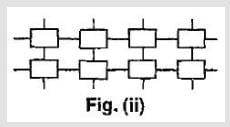Olympiad Test: Synthetic Fibres And Plastics - Class 7 MCQ
20 Questions MCQ Test Advance Learner Course: Science Class 7 - Olympiad Test: Synthetic Fibres And Plastics
The world's first fully synthetic plastic was:
Figure(ii) shows an arrangement of units that make up plastics. Name the arrangement:


Which of the following are natural fibres?
_________ is the first fully synthetic fibre.
A polymer is a large molecule composed of many repeated units. What is a polyester composed of?
Which of the following material is a mixture of two fibres?
Which of the following fibres is used for making parachutes?
One of the advantages of nylon over rayon is that nylon:
Identify the type of plastic that can best be used to make electrical switches.
Modern non-stick cookware and the flat end of an electric iron has a coating of a polymer. Identify the name of the polymer.
Which of the following is a natural fibre obtained from plants?
Which one of the following is thermosetting plastic?
Pickles are stored in plastic bottles mainly because they are:
Polyethylene terephthalate belongs to which class of synthetic polymer?
Which of the following is non-biodegradable?
Which term is used for polymers made up of a large number of glucose units?
|
18 videos|34 docs|19 tests
|



















